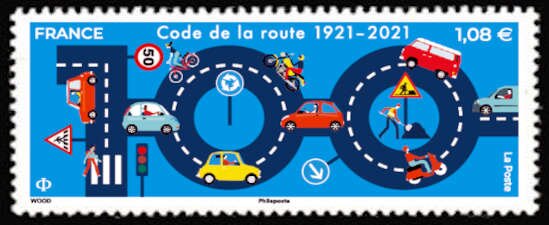Stamp: National Highway Code, Centenary (France 2021)
National Highway Code, Centenary (France 2021)
14 June (France ) within release National Highway Code, Centenary goes into circulation Stamp National Highway Code, Centenary face value 1.08 Euro
| Stamp National Highway Code, Centenary in catalogues | |
|---|---|
| Colnect codes: | Col: FR 2021-30 |
Stamp is horizontal format.
Stamp National Highway Code, Centenary it reflects the thematic directions:
A car is a wheeled, self-powered motor vehicle used for transportation and a product of the automotive industry. Most definitions of the term specify that cars are designed to run primarily on roads, to have seating for one to eight people, to typically have four wheels with tyres, and to be constructed principally for the transport of people rather than goods. The year 1886 is regarded as the birth year of the modern car. In that year, German inventor Karl Benz built the Benz Patent-Motorwagen. Cars did not become widely available until the early 20th century. One of the first cars that was accessible to the masses was the 1908 Model T, an American car manufactured by the Ford Motor Company. Cars were rapidly adopted in the United States of America, where they replaced animal-drawn carriages and carts, but took much longer to be accepted in Western Europe and other parts of the world.
A road is a thoroughfare for the conveyance of traffic that mostly has an improved surface for use by vehicles (motorized and non-motorized) and pedestrians. Unlike streets, whose primary function is to serve as public spaces, the main function of roads is transportation.
Transport or transportation is the movement of people, animals and goods from one location to another. Modes of transport include air, rail, road, water, cable, pipeline and space. The field can be divided into infrastructure, vehicles and operations. Transport is important because it enables trade between people, which is essential for the development of civilizations.



